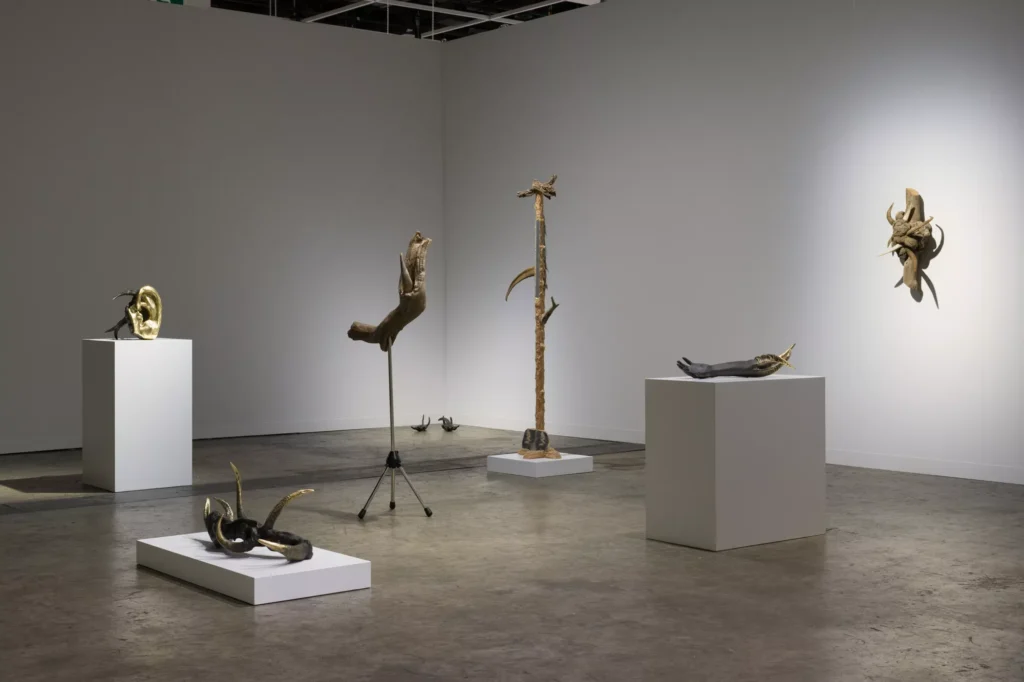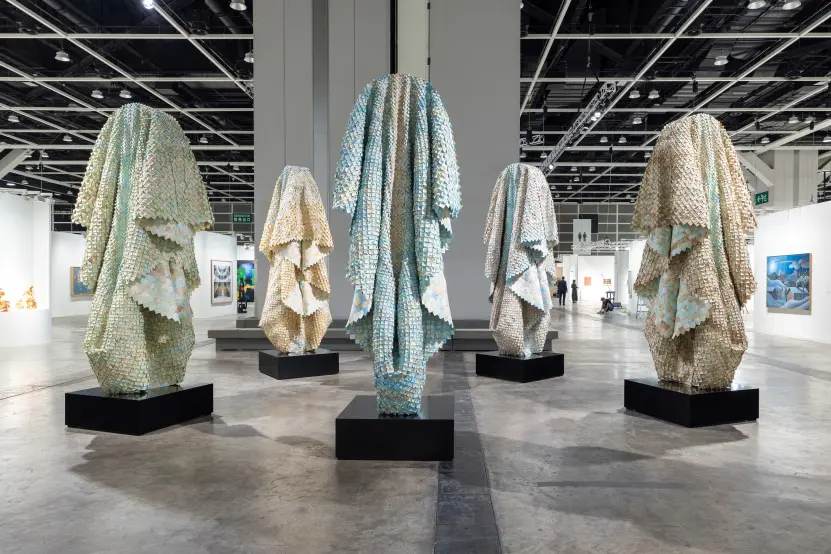Art Basel Hong Kong attracted 242 exhibitors from 40 countries, 65 more than 2023, despite China’s economic slowdown and concerns over Hong Kong’s legal oversight. High enthusiasm among exhibitors and attendees, however, did not translate into higher sales compared to previous years.
Curated by Alexie Glass-Kantor, Encounters, one of the sections of the fair, presents 16 large-scale projects by diverse artists, including 11 commissioned works. Highlights include Haegue Yang’s “Contingent Spheres” and Ming Wong’s “Friendship First.” Daniel Boyd’s off-site project at Pacific Place delves into identity and history, supported by Swire Properties.
In this year’s edition, Japanese gallery Take Ninagawa stands out with vibrant works by artists such as Tsuruko Yamazaki and Shinro Ohtake. Yamazaki’s use of found paint cans and bold geometric patterns drew attention, while Ohtake’s collages offered a unique perspective on post-war Japan.

Another highlight is Kosaku Kanechika’s booth, featuring Junko Oki’s intricate textile-based art inspired by personal history and emotion. Axel Vervoordt Gallery presents works by artists like El Anatsui and Sopheap Pich, exploring themes of community and transformation through recycled materials and innovative techniques.
Flowers booth showcases Jantsankhorol Erdenebayar’s sculptures rooted in Mongolian culture, blending human and animal elements to reflect contemporary concerns. WAITINGROOM’s presentation of Fuyuhiko Takata’s videos challenges corporate masculinity, inviting laughter and contemplation from viewers.
Empty Gallery features Jes Fan’s organic sculptures and Jacqueline Kiyomi Gork’s silicone wall sculpture, highlighting innovative materials and techniques. Grotto Fine Art showcases local Hong Kong artists, conveying the city’s emotional landscape amidst rapid change.

Dastan presents Mohsen Vaziri Moghaddam’s abstract works created with spontaneity and joy, despite declining eyesight. BANK divides its booth into past and future sections, showcasing historic fiber artworks alongside contemporary pieces, illustrating a multigenerational approach.
This edition drew keen collectors, especially from the younger generation. China has seen a rise in new and ambitious collectors, which has shifted the market and pushed the country ahead of the UK to become the second-largest art market, despite a general economic slowdown.

The emerging collectors in China have varied tastes, preferring artworks priced between $50,000 and $1 million, and are interested in different mediums and formats, regardless of artists’ backgrounds. Many of these collectors come from finance and technology sectors, a change from previous generations who were mainly in real estate and medicine.
Participating galleries are keen to tap into this burgeoning market, with strategies ranging from showcasing works by emerging artists with lower price points to catering to Asian buyers’ preferences for pieces by Asian artists.
Notable sales were made despite a moderate economic climate, including pieces by renowned artists such as Mark Bradford, Yayoi Kusama, and Willem de Kooning. The fair also witnessed sales from regional and local galleries, indicating a robust interest in art across the region, with Hong Kong’s 10 Chancery Lane Gallery and Shanghai’s Linseed Gallery reporting early successes in selling works by both established and emerging artists.



